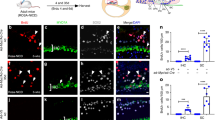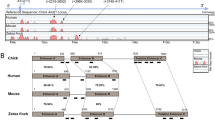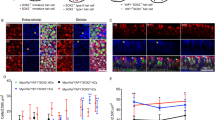Abstract
Loss of receptor hair cells in the cochlea accounts for a significant proportion of hearing impairment in the population1. Hair cells can be lost as a consequence of viral or bacterial insult, aging, and damage from intense sound or aminoglycoside antibiotics. The generation of replacement hair cells following damage by sound or drugs has been clearly demonstrated in birds2–4; the chick is the best–studied model for auditory hair cell regeneration5. New hair cells arise as progeny from an otherwise nondividing supporting cell population induced to proliferate by the damage6–12. Functional recovery of hearing accompanies this cellular recovery process13,14. The signals and pathways responsible for regenerative proliferation are unknown. Here we show that proliferation is induced in the undamaged receptor epithelium by agents that increase cyclic AMP levels, and that following this stimulation hair cells become labeled with proliferation markers. This remarkable proliferative response is blocked by inhibitors of the cAMP–regulated protein kinase A (PKA). In addition we show that the proliferative response induced by in vitro gentamicin damage is also significantly blocked by PKA inhibitors. These observations are the first to identify a signaling pathway that plays a role in regenerative proliferation in the auditory receptor epithelium.
This is a preview of subscription content, access via your institution
Access options
Subscribe to this journal
Receive 12 print issues and online access
$209.00 per year
only $17.42 per issue
Buy this article
- Purchase on Springer Link
- Instant access to full article PDF
Prices may be subject to local taxes which are calculated during checkout
Similar content being viewed by others
References
Nadol, J.B. Jr. Hearing loss. N. Engl J. Med. 329, 1092–1102 (1993).
Corwin, J.T. & Cotanche, D.A. Regeneration of sensory hair cells after acoustic trauma. Science 240, 1772–1774 (1988).
Ryals, B.M. & Rubel, E.W. Hair cell regeneration after acoustic trauma in adult Cotumix quail. Science 240, 1774–1776 (1988).
Lippe, W.R., Westbrook, E.W. & Ryals, B.M. Hair cell regeneration in the chicken cochlea following aminoglycoside toxicity. Hear. Res. 56, 203–210 (1991).
Cotanche, D.A. et al. Hair cell regeneration in the bird cochlea following noise damage or ototoxic drug damage. Anat Embryol. (Berl). 189, 1–18 (1994).
Girod, D.A., Duckert, L.G. & Rubel, E.W. Possible precursors of regenerated hair cells in the avian cochlea following acoustic trauma. Hear. Res. 42, 175–194 (1989).
Corwin, J.T. et al. Hair cell regeneration: The identities of progenitor cells, potential triggers and instructive cues. Ciba Found. Symp. 160, 103–20 (1991).
Raphael, Y. Evidence for supporting cell mitosis in response to acoustic trauma in the avian inner ear. J. Neurocytol. 21, 663–671 (1992).
Hashino, E. et al. Hair cell regeneration in the adult budgerigar after kanamycin ototoxicity. Hear. Res. 59, 46–58 (1992).
Hashino, E. & Salvi, R.J. Changing spatial patterns of DNA replication in the noise-damaged chick cochlea. J. Cell Sci. 105, 23–31 (1993).
Stone, J.S. & Cotanche, D.A. Identification of the timing of S phase and the patterns of cell proliferation during hair cell regeneration in the chick cochlea. J. Comp. Neurol. 341, 50–67 (1994).
Bhave, S.A. et al. Cell cycle progression in gentamicin-damaged avian cochleas. J. Neurosci. 15, 4618–4628 (1995).
McFadden, E.A. & Saunders, J.C. Recovery of auditory function following intense sound exposure in the neonatal chick. Hear. Res. 41, 205–215 (1989).
Tucci, D.L. & Rubel, E.W. Physiologic status of regenerated hair cells in the avian inner ear following aminoglycoside ototoxicity. Otolaryngol. Head Neck Surg. 103, 443–450 (1990).
Jorgensen, J.M. & Mathiesen, C. The avian inner ear: Continuous production of hair cells in vestibular sensory organs, but not in the auditory papilla. Naturwissenschaften 75, 319–320 (1988).
Lambert, P.R. Inner ear hair cell regeneration in a mammal: Identification of a triggering factor. Laryngoscope 104, 701–718 (1994).
Yamashita, H. & Oesterle, E.C. Induction of cell proliferation in mammalian inner-ear sensory epithelia by transforming growth factor alpha and epidermal growth factor. Proc. Natl. Acad. Sci. USA 92, 3152–3155 (1995).
Dumont, J.E., Jauniaux, J.C. & Roger, P.P. The cyclic AMP-mediated stimulation of cell proliferation. Trends Biochem. Sci. 14, 67–71 (1989).
Marx, J. Two major signal pathways linked. Science 262, 988–990 (1993).
Oesterle, E.C. et al. Hair-cell regeneration in organ cultures of the postnatal chicken inner ear. Hear. Res. 70, 85–108 (1993).
Forge, A. & Richardson, G. Freeze fracture analysis of apical membranes in cochlear cultures: Differences between basal and apical-coil outer hair cells and effects of neomycin. J. Neurocytol. 22, 854–867 (1993).
Bartolami, S., Goodyear, R. & Richardson, G. Appearance and distribution of the 275 kD hair-cell antigen during development of the avian inner ear. J. Comp. Neurol. 314, 777–788 (1991).
Oberholtzer, J.C. et al. The 28-kDa calbindin-D is a major calcium-binding protein in the basilar papilla of the chick. Proc. Natl. Acad. Sci. USA 85, 3387–3390 (1988).
Dartt, D.A. et al. Cyclic nucleotide-dependent enzyme secretion in the rat lacrimal gland. J. Physiol. (Lond.) 352, 375–384 (1984).
Hentrich, F., Gothert, M. & Greschuchna, D. Involvement of cAMP in modulation of noradrenaline release in the human pulmonary artery. Naunyn Schmiedebergs Arch. Pharmacol. 330, 245–247 (1985).
Author information
Authors and Affiliations
Corresponding author
Rights and permissions
About this article
Cite this article
Navaratnam, D., Su, H., Scott, SP. et al. Proliferation in the auditory receptor epithelium mediated by a cyclic AMP–dependent signaling pathway. Nat Med 2, 1136–1139 (1996). https://doi.org/10.1038/nm1096-1136
Received:
Accepted:
Issue Date:
DOI: https://doi.org/10.1038/nm1096-1136
This article is cited by
-
Regeneration of hair cells in the mammalian vestibular system
Frontiers of Medicine (2016)
-
Supporting Cell Division Is Not Required for Regeneration of Auditory Hair Cells After Ototoxic Injury In Vitro
Journal of the Association for Research in Otolaryngology (2010)
-
cAMP-induced Auditory Supporting Cell Proliferation is Mediated by ERK MAPK Signaling Pathway
Journal of the Association for Research in Otolaryngology (2010)
-
Stimulating hair cell regeneration: On a wing and a prayer
Nature Medicine (1996)



